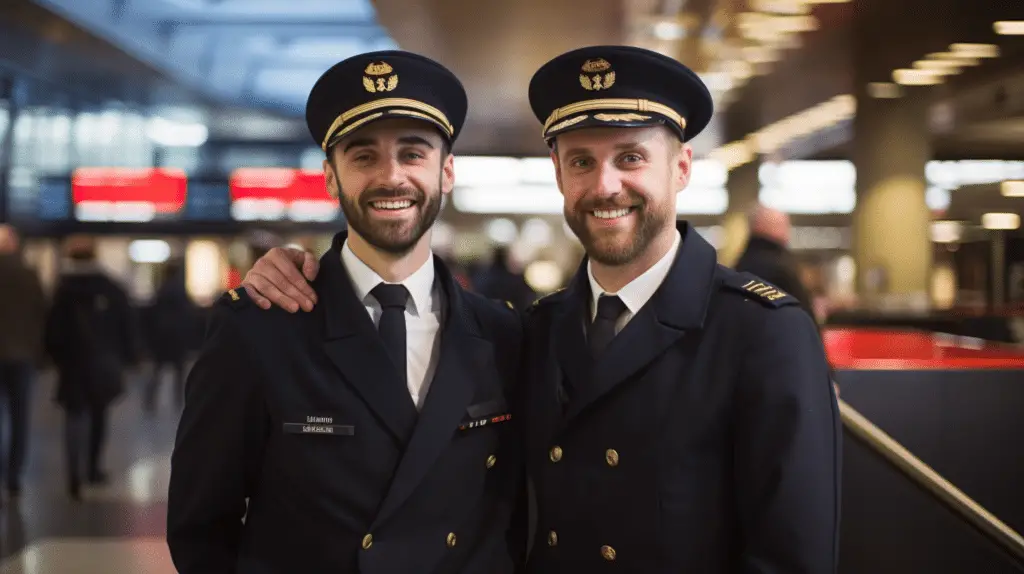What Should A Flying Pilot Wear?

Stepping into the vast expanse of the skies evokes a sense of thrill, adventure, and gravitas.
Picture this: a serene cloud cover, the sun’s rays peeking through, and the hum of a jet engine. Now, imagine the protagonist behind that engine.
Their attire isn’t merely about aesthetics—it’s a tale of duty, pride, and tradition. Dive with me into the detailed depths of pilot fashion and its significance.
What is the dress code for a pilot?
In the aviation world, a pilot’s attire is a mix of tradition and professionalism. White shirts with epaulets denote rank, complemented by navy or black ties and matching trousers.
Their navy jacket, marked with gold stripes, signifies experience and expertise.
Polished black or brown leather shoes are chosen for both elegance and functionality.
Insights into suitable pilot footwear, including options like “shoes for pilots” and the feasibility of “wearing boots,” are essential for understanding dress code subtleties.
Completing the outfit is the pilot’s cap with the airline’s insignia, a symbol of loyalty and professional identity.
What do female pilots wear?
Female aviators, a blend of grace and grit, often don a uniform echoing their male counterparts. Their attire usually comprises a crisp white shirt adorned with those significant epaulets.
Some may choose tailored skirts over trousers, ensuring they’re of an apt length, paired with tights. Footwear, a critical component, remains consistent: polished, pragmatic black or brown leather shoes.
Of course, the pilot’s hat, a symbol of identity, rests atop their heads, showcasing the airline’s emblem.
Can a pilot fly without a uniform?
Diving straight into the heart of the matter, yes, there are instances where a pilot might be without their signature uniform.
Especially during private or charter flights, conventional attire might take a backseat. Major commercial airliners, on the other hand, emphasize the uniform’s significance.
It is an emblem of trustworthiness and professionalism, assisting passengers in identifying the flight’s crew—an essential factor during unforeseen emergencies.
ConcessiAons such as shedding jackets or ties might be granted for comfort on prolonged flights.
Can pilots wear their uniform in public?
Pilots often sport their uniforms in public arenas, stepping beyond the cockpit confines. Numerous airlines recommend this practice when pilots are en route to the airport or during layovers.
Such a sight enhances the airline’s image and instills a sense of pride in the pilot. Despite this, it’s paramount that pilots uphold the highest standards of behavior.
After all, they bear the mantle of representing their prestigious airline.
In the vast skies, beyond the humming engines and beneath the clouds, uniforms play a pivotal role. They are not just clothesA but symbols of duty, identity, and pride.
So, the next time you board a flight, know that the attire of the person steering the ship holds stories, traditions, and a legacy.
What Should A Flying Pilot Wear Conclusion
Pilots embody technical prowess and a profound sense of duty and responsibility. The uniform they wear amplifies this sentiment.
Beyond being a mere ensemble, it carries the weight of tradition, respect, and pride. Every stitch, stripe, and emblem is an ode to their unwavering dedication and the faith passengers place in them.
While fashion trends may come and go, the pilot’s uniform remains timeless, transcending fleeting style to symbolize safety, commitment, and honor.
As we tread through airports and board our flights, let’s remember to appreciate the more profound stories woven into these uniforms, recognizing the sacrifices and passion that propel our journeys across the horizon.
